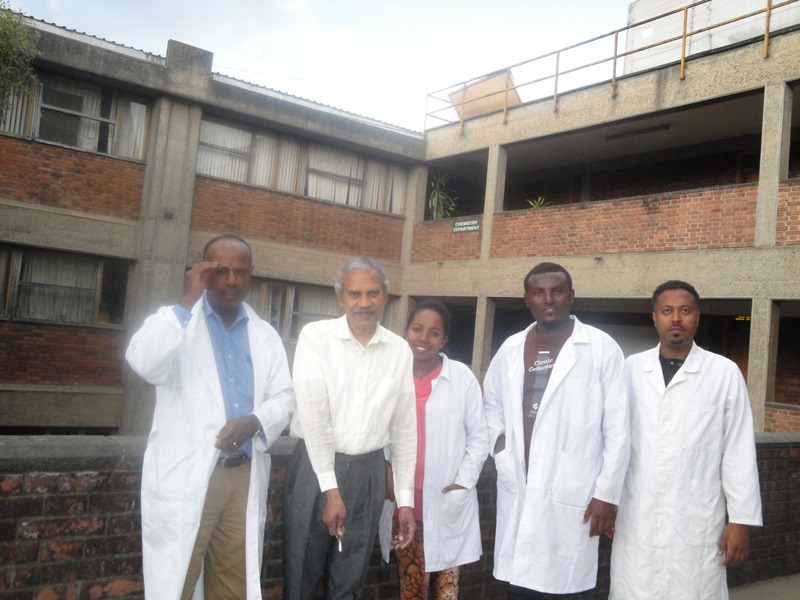Dr. Beshah' original grant was awarded to develop, characterize and evaluate the effectiveness and sustainability of innovative high capacity aluminum oxide based materials and composite oxides for fluoride removal in rural Ethiopia. The project aimed at socioeconomic and entrepreneur aspects to find ways to make the technologies sustainable in the Ethiopian context. The project also received a supplement to explore scaling up fluoride treatment technologies in rural Ethiopia. The defluoridation technologies implemented and tried by various organizations in Ethiopia yet to be proved sustainable due to inadequate capacity of the organizations dealing with the technologies, lack of understanding of the limitations associated with the technologies, affordability and lack of awareness by the users, and absence of proper material supply chain either through the government channel or by private sectors or in partnership.
During the project, the team conducted a concise stakeholder analysis outlining both a categorical and individualized map of institutions and persons relevant in implementation of fluoride removal technologies (drivers for scaling up). The team also visited the water, health and education bureaus in four fluoride affected regional states (Afar, Oromia, Southern Nation, Nationalities and Peoples Region, and Somali), as well as fluoride affected woreda, Kebeles or communities in each regional state.
The main objective of the field visits in the sample areas was to conduct situation or stakeholder analysis, assess the situation of field implemented technologies, and carryout socioeconomic surveys. Regional water bureaus were involved in selecting the assessment sites and targets for scaling scaling through needs assessments. Document review was also an important source of data to capture the existing gaps for scaling up the fluoride removal technologies in rural villages in Ethiopia. With this in mind, policy/strategy documents, programs, and action plans were reviewed to come up with a proper strategy.
Cognizant of the fact that fluorosis is a serious public health problem affecting the national development, the Ministry of Water, Irrigation and Electricity (MoWIE) has established a National Fluorosis Mitigation program which is aiming at the implementation intervention measures including implementation of Water Defluoridation Technologies. Recently, the NFMPO and other NGOs, particularly the Oromo Self Help Organization (OSHO) and the Catholic Relief Service (CRS) Ethiopia, are making efforts to implement water defluoridation technologies in rural areas both at household and community scales. The key issue related to the ongoing technological interventions is ensuring the overall sustainability and building local capacity.
In Addition, USAID supports the Government of Ethiopia’s efforts by incorporating water, sanitation and hygiene activities into its health, education, humanitarian assistance and democracy and governance programs, and water resources management into its agriculture and food security activities. Among many other large scale programs and projects, USAID provided a grant of USD $500,000 to OSHO which has been used for the installation of 12 community scale fluoride removal units based on a bone char and production system of hydroxyappatite material in Modjo over a period of 2 to 3 years starting from early 2014. The output of this project will have strong impact on the USAID’s support to Ethiopia to enhance access to safe drinking water in the Ethiopian Rift Valley where at least 14 million people are at risk of dental, skeletal and systemic fluorosis. The strategy for scale up can be used all implementing partners.
The output of this project will also have an impact on water science and technology education and research in Ethiopia. The problem of fluoride in particular and water quality in general will be included in graduate curriculum which in the process of development with financial support from the World Bank through soft loan mechanism for the Government of Ethiopia. The Ministry of Science and Technology of Ethiopia also developed an interest to support further field testing and dissemination of fluoride treatment technologies.
Publications
Dessalegne, M., Zewge, F., and Diaz, I., Aluminum hydroxide supported on zeolites for fluoride removal from drinking water, J Chem Technol Biotechnol (2016).
https://doi.org/10.1002/jctb.5041
Dessalegne, M., Zewge, F., Pfenninger, N. et al. "Layered Double Hydroxide and Its Calcined Product for Fluoride Removal from Groundwater of Ethiopian Rift Valley." Water Air Soil Pollut, vol. 227, 2016, p. 381.
https://doi.org/10.1007/s11270-016-3079-5
Wendimu, G., Zewge, F., and Mulugeta, E. "Aluminium-Iron-Amended Activated Bamboo Charcoal (AIAABC) for Fluoride Removal from Aqueous Solutions." Journal of Water Process Engineering, vol. 16, 2017, pp. 123-131.
https://doi.org/10.1016/j.jwpe.2016.12.012Zewge, F., Combined aluminium sulfate/hydroxide process for fluoride removal from drinking water, Bull. Chem. Soc. Ethiop. 2016, 30(3), 1-11. Bull. Chem. Soc. Ethiop. 2016, 30(3), 391-401,
http://dx.doi.org/10.4314/bcse.v30i3 



